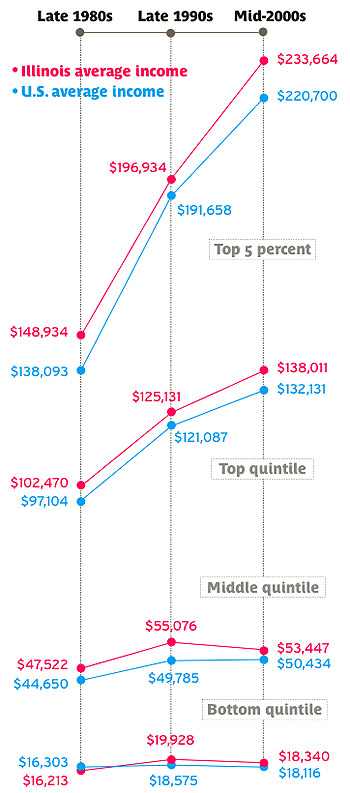You’re working hard, and your income is rising, but that new sports car may be getting further out of your reach. Income gaps in Illinois are getting wider—between the rich and the poor, and between the rich and the richer.
Illinois ranked sixth among the states in greatest increases in income inequality between the top and bottom fifths of households from the late 1990s to the mid-2000s, according to the U.S. Census Bureau. In inflation-adjusted terms, the top increased 10.3 percent, while the bottom decreased 8 percent. Illinois ranked fourth in the increase in inequality between the top and middle fifths during the same time frame. (The middle decreased 3 percent.) Zooming in further: The average income of the top 5 percent of households increased 18.7 percent in that time period. Illinois has been hit particularly hard by the transition from manufacturing jobs to lower-paying service-sector jobs, says Ralph M. Martire, executive director of the Center for Tax and Budget Accountability.
Illinois isn’t alone in seeing this pattern. In 36 other states, income grew faster for the richest families than for the poorest. (These statistics are printed and analyzed in an April 2008 report from the Center on Budget and Policy Priorities, a left-leaning think tank.)
When compounded with the sluggish economy, the widening income gap is likely to harm lower earners, says Elizabeth McNichol, one of the authors of the report. "It’s particularly troubling that this is happening when we are going into a time when gas, food, and housing costs are on the rise," she says. "The poor and middle-income haven’t shared in the prosperity and aren’t prepared for the recent economic downturn." Hourly wage growth has slowed along with the economy, going from a one-year change of 4.3 percent before inflation in January 2007 to 3.7 percent in January 2008. Because inflation is about twice what it was a year ago, real hourly and weekly earnings are down about 1 percent, compared with an average 2 percent growth one year ago.
But Gary S. Becker, a Nobel Prize winner and economics professor at the University of Chicago, argues that the income gap isn’t necessarily a bad thing: "It’s good because the benefits going to those with higher education have increased." We should be rewarding education, Becker says—though he argues there’s a need to raise college attendance among recent high school graduates.

How We Compare
Check Raise
A rising tide lifts all boats, as long as you have a yacht. The chart at right shows how income distribution has changed over the last 20 or so years, in Illinois and in the United States as a whole, adjusted to 2005 dollars. Sources: Center on Budget and Policy Priorities, Economic Policy Institute
By the Numbers
Some occupations are doing better than others as incomes draw apart. Here are the hourly wages in 1999 and 2006, expressed in 1999 dollars, for selected professions in the Chicago area. Source: U.S. Bureau of Labor Statistics
Food prep and service
1999: $6.72
2006: $6.41
Farming, fishing, and forestry
1999: $8.80
2006: $8.38
Building and grounds maintenance
1999: $8.83
2006: $8.51
Business and financial operations
1999: $19.73
2006: $22.66
Management
1999: $30.17
2006: $33.54
Law
1999: $29.46
2006: $36.50


